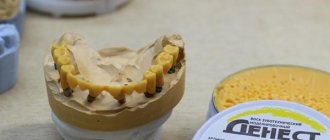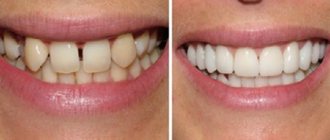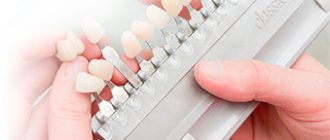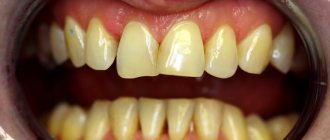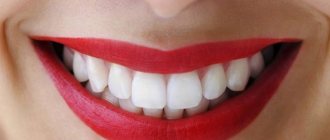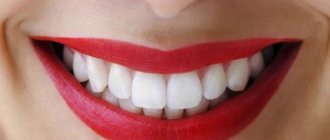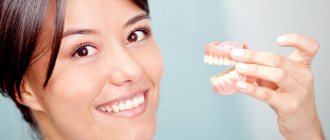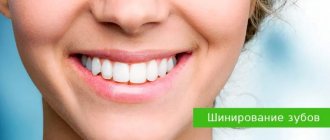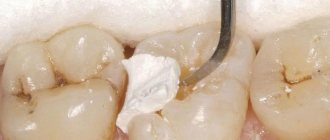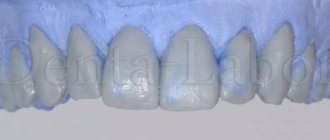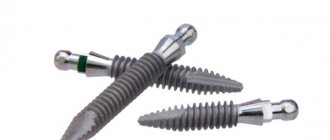Anatomical modeling according to Schultz
The basic principle of the technology is the division of each tooth into segments.
Anatomical modeling involves creating wax models of teeth that respect natural morphology. The main attention is paid to those elements that are involved in closing the jaws (occlusion). The basic principle of this technique is to divide each tooth into segments and accurately reproduce them on a wax model. Work on creating models of anterior teeth is carried out according to the following algorithm :
- Applying a separation agent to the plaster stump, then placing a polymer cap on it.
- Marking the edge of the cap with wax in a contrasting color.
- Modeling of cones on a plaster stump, the dimensions of which are based on the parameters of adjacent teeth.
- Applying wax along the incisal edge and checking for correct function in the articulator.
- Creation of models of convex medial and distal ridges.
- Checking the inclination of the teeth relative to the distal edge.
- Removing excess wax along the edges.
Using a similar algorithm, models of teeth of other groups are recreated, taking into account their natural features and functions.
Stages of dental restoration
| Preparation: professional teeth cleaning - removal of pigmented plaque and stones (more details) |
| selection of colors for restoration |
| anesthesia |
| Next, we put on a special rubber lining - caferdam, which ensures complete isolation of the prepared teeth from the mucous membrane |
| dental treatment, preparation of affected areas or removal of old fillings, if necessary, installation of fiberglass pins |
| direct restoration of the tooth using a light-curing composite of the 5th generation, the restoration is carried out by layering different shades of material, which ensures the natural appearance of the tooth, and maybe even better than natural. |
| modeling with burs, tooth grinding. |
Lomiashvili teeth modeling
The author of the technique is Larisa Lomiashvili, who developed the technology of modular modeling using the direct method, that is, directly in the oral cavity. The main principle is the most accurate reproduction of natural forms, especially for the teeth of the upper jaw, which are the most difficult for the dentist due to difficult access.
Lomiashvili's textbook gives a detailed description
This technique makes it possible to model a tooth directly in the oral cavity.
features of the anatomical structure of all teeth, with tubercles, depressions, ridges, grooves. The restoration of this building is carried out using modular technology. A composite material of the same shape, but in a larger volume, is applied to the central module. Thus, filling the free space of the tooth is carried out according to the “matryoshka” principle, when larger forms absorb smaller ones.
In this case, it is not necessary to use one material. Various composites can be used, differing, among other things, in color, to achieve maximum identity with a natural tooth. When using this technology, it is always possible to correct the shortcomings of the previous layer with the subsequent one.
Methods of artistic modeling and restoration
There are two methods of artistic restoration of teeth - direct and indirect.
In the case of direct restoration, light-curing filling materials are used, and the work itself is carried out by a dental therapist in the patient’s oral cavity.
At the preparatory stage, a number of activities are carried out: hygienic cleaning of teeth, selection of the color of filling material, administration of anesthesia. At the second stage, the preparation of damaged or defective teeth is carried out. Next, if there is such a need, the doctor fixes fiberglass pins in the root canals. The last stage is the actual artistic restoration of teeth: a dental crown is modeled from composite materials, which is then ground and polished.
With the indirect method, both composite and ceramics can be used, and the microprosthesis itself is manufactured in the laboratory. The first two stages are broadly the same as those described above, and then impressions are taken of the ground teeth. Using these impressions, the dental technician creates orthopedic products, which are fixed on the patient’s teeth at the next appointment.
Artistic modeling and restoration of teeth using the indirect method, as a rule, gives a better result in terms of aesthetics, strength and durability.
Vetchinkin method
The author of another technique aimed at solving issues of functional occlusion coupled with the aesthetics of the dentition is Anton Vetchinkin. He created a technology called “Aesthetic foundations for the formation of teeth,” which is based on three principles of bionics (the science of connections and patterns in living nature):
- The law of the cone, which implies that the stability of objects is provided by two multidirectional forces - the force of growth and the force of gravity, which balance each other.
- Law of the logarithmic spiral. The strength of natural objects is ensured by the fact that their structure experiences twisting (shells are an example).
- The law of differentiation of form, according to which individual objects can achieve greater efficiency in their development by combining into complex systems.
Expert opinion. Dentist Verbitsky A.L.: “ The author of the technique proposes to use these laws of bionics when modeling artificial teeth. Thus, the listed principles make it possible to determine control points and lines of the future model and thereby recreate the shape of the tooth as accurately as possible. Thus, auxiliary landmarks are added to the points that are already used in the practice of dental technicians (medial and distal edges and others).
Possibilities of artistic dental restoration and its price
Thanks to innovative technologies, modern dentistry makes it possible to eliminate defects such as:
- cracks and chips;
- large distance between teeth;
- uneven tooth shape;
- flaws and darkening of enamel, etc.
Of course, every patient who turns to us for help is concerned with the question of how much artistic tooth restoration costs. A specialist will be able to answer this only after examining and diagnosing the condition of the oral cavity. Moreover, doctors of related specialties may be involved for consultation. The dentists of our clinic are highly qualified and constantly work to improve their professional skills, undergoing internships in Germany and the USA.
3D modeling
3D modeling technology allows you to create a three-dimensional model of the jaws.
Modern technologies have firmly established themselves in dentistry. One of them is 3D modeling, with which you can create three-dimensional models of jaws. For this, a so-called three-dimensional tomograph is used, consisting of a computer itself and a scanner.
The scanner continuously takes pictures over a certain period of time and transfers them to the computer. Thanks to them, the doctor can determine not only the structural features of the jaws, but also the location of blood vessels, nerves, and maxillary sinuses. In this case, there is no need to make casts and impressions: based on the information received, the doctor can create a three-dimensional model of the future structure on the computer screen in a few minutes.
The information obtained is transmitted to a special milling machine, which automatically grinds the prosthesis. The technology is used for the restoration of both anterior and chewing teeth: thanks to the high precision of the method, it is possible to achieve ideal functional occlusion. Using 3D modeling, prosthetics, ceramic crowns, and veneers can be made.
Despite the introduction of high technologies into dentistry, the work of a dental technician continues to remain not only a craft with precision calculations and honed skills, but also an art. It is not without reason that it is believed that technicians are a kind of sculptors, artists who create real works of art in the form of beautiful smiles of patients.
Restoration of anterior teeth
Artistic restoration of the front teeth requires even higher demands on the aesthetic side of the issue, because a beautiful smile is one of the most important components of everyday communication between people and an indispensable part of the image of a successful person. The best way to give your front teeth a flawless appearance is to install ceramic veneers.
Dental porcelain, used for artistic restoration of front teeth, is a unique material with many advantages:
- it imitates with perfect accuracy many of the properties of tooth enamel (translucency, degree of light reflection, etc.), and surpasses it in terms of strength;
- Over time, ceramics do not lose their color or become stained;
- Dental porcelain eliminates any allergic reactions of the body.
True, the cost of artistic dental restoration with ceramic veneers is very high and not affordable for everyone.
Restoring anterior teeth with composite materials also has a number of advantages. This is a moderate cost, quick implementation of all dental procedures (usually in one visit), minimal intervention in the structure of dental tissues. However, in terms of aesthetics, strength and resistance to dyes, the composite is very inferior to ceramics.
The question of how much artistic dental restoration costs cannot be answered unambiguously: it depends on the chosen method, the material used, the amount of work and many other factors. Approximate prices at the Doka-Dent clinic are shown in the table on this page.
Artistic restoration and modeling of teeth
Artistic modeling and restoration of teeth make it possible to restore damaged dental tissues using artificial materials. For this purpose, composite filling compounds or special overlays – veneers – can be used. The procedure allows you to fully restore the correct shape, aesthetic appearance and chewing functions of the tooth. Thanks to the use of modern technologies, discomfort for the patient is minimal. Artistic dental restoration in Moscow is performed at a first-class professional level by experienced dentists working in clinics of the Medline-Service network.
Prices
| Aesthetic restoration | 6800 rub. |
| Aesthetic restoration with nanohybrid composites | 12000 rub. |
Buy Artistic modeling and restoration of teeth, L. M. Lomiashvili, L. G. Ayupova
Artistic modeling and restoration of teeth
The book presents materials from the scientific and practical activities of the authors on the problem of modeling dental crowns and artistic restoration. The publication demonstrates original methodological approaches used in restoring lost teeth, taking into account knowledge of the clinical anatomy of the human dentofacial apparatus. The manual consists of 4 chapters and appendices. The first three chapters of the book outline the principles and methodological approaches for modeling various groups of teeth. An odontoscopy algorithm is presented that allows one to evaluate the qualitative characteristics of teeth, and odontometric methods are presented. Chapter 4 reflects the clinical application of the basics of artistic modeling. This section provides a comparative analysis of the advantages and disadvantages of restoration methods. Using various clinical examples, the features and methods of restoring teeth and dentition are discussed. The authors’ great desire to combine information on anatomy, physiology, modeling and restoration of teeth in clinical dentistry led to the creation of a sufficient amount of illustrative material (over 1000 color drawings). The new edition has significantly expanded the clinical part of the manual. The principles of teeth modeling are presented, the relationship between the shape of teeth and the function of the dentofacial apparatus is considered. A systematic approach to artistic dental modeling is presented.
The book is intended for students of dental faculties of higher medical educational institutions, students of dental technical departments of medical colleges, and can also be used by dentists, teachers of dental faculties, and dental technicians in practical work.
If you have not read “Artistic Modeling and Dental Restoration,” you can purchase it in the following stores:
Buy “Artistic modeling and restoration of teeth”, L. M. Lomiashvili, L. G. Ayupova in stores:
When you purchase in this store, you return it to your personal BM account and become a contender for the prize of the month from BookMix.ru! More information about the promotion
You can purchase the book Artistic Modeling and Dental Restoration cheaper than in regular stores; to do this, select the online store that is most suitable for you and follow the “Buy” link. You will be able to use various payment options for goods that are most convenient for you.
You can find information about payment and delivery methods on the page of each store after you click on the link Buy the book Artistic modeling and restoration of teeth .
Direct full restoration
The advantage of direct artistic restoration of a tooth is the ability to restore its functions and shape in one visit to the dentist. The procedure is also minimally invasive. Modeling and restoration of destroyed dental tissues is performed directly in the patient’s oral cavity. Indications for direct restoration are:
- the need to change the shape of fangs and incisors; the presence of chips and cracks in the enamel; the need to restore the position of the crowns by extension; change in tooth shade.
Materials
Composite filling materials are used to model and restore dental tissues. They are selected taking into account the shade of the patient's enamel in order to provide the necessary aesthetic effect. Composite materials have such advantages as affordability, speed of production, and ease of adjusting the shape of teeth restored with their help. Pins can also be used during restoration. They are made from various metals (titanium, silver, etc.).
Stages
- Preparation. Before starting the restoration, the doctor removes plaque and stone; if there is caries, the affected tissue is drilled out. If necessary, anesthesia is performed. The tooth to be restored is isolated from saliva and wet breath. Selection of material . For this purpose, a special scale is used to determine the color of the patient’s enamel. In accordance with it, the doctor selects a composite material of the appropriate shade for extensions. Restoration of dental tissues . If a tooth is destroyed by 50% or more, a pin is installed in the root canal before restoration. Then layer-by-layer application of the composite material is performed. Final simulation. The tooth is ground to the desired shape, then its surface is ground and polished.
Methods of artistic modeling and restoration
There are two methods of artistic restoration of teeth - direct and indirect.
In the case of direct restoration, light-curing filling materials are used, and the work itself is carried out by a dental therapist in the patient’s oral cavity.
At the preparatory stage, a number of activities are carried out: hygienic cleaning of teeth, selection of the color of filling material, administration of anesthesia. At the second stage, the preparation of damaged or defective teeth is carried out. Next, if there is such a need, the doctor fixes fiberglass pins in the root canals. The last stage is the actual artistic restoration of teeth: a dental crown is modeled from composite materials, which is then ground and polished.
With the indirect method, both composite and ceramics can be used, and the microprosthesis itself is manufactured in the laboratory. The first two stages are broadly the same as those described above, and then impressions are taken of the ground teeth. Using these impressions, the dental technician creates orthopedic products, which are fixed on the patient’s teeth at the next appointment.
Artistic modeling and restoration of teeth using the indirect method, as a rule, gives a better result in terms of aesthetics, strength and durability.
Indirect full restoration
When performing artistic restoration of teeth using the indirect method, pre-fabricated individual microprostheses are used - veneers, inlays, crowns. Their modeling is carried out in a dental laboratory. Due to the multi-stage nature of the restoration, you will need to visit the dentist at least twice. Indications for tooth restoration are:
- significant destruction of the coronal part; large chips of the cutting edge; unaesthetic appearance after caries treatment.
Indirect artistic restoration of anterior teeth is often prescribed to restore/correct the shape of a group of incisors. The procedure allows you to eliminate various functional and aesthetic defects: chipped cutting edges, enlarged interdental spaces, discoloration of enamel.
Materials
To restore dental tissues, microprostheses made of metal, ceramics, and metal-ceramics are used. These materials are superior in strength and abrasion resistance to composite compounds used to restore dental tissue using the direct method. After removing a large amount of hard tissue during caries treatment, the dentist may recommend a restoration using ceramic inlays as an alternative to prosthetics.
Stages
- Preparation . At your first visit to the dentist, the doctor will determine the type of structure suitable for restoring the shape of the tooth and, if necessary, draw up a treatment plan. Then the specialist will make an impression from which a microprosthesis will be made. Making veneers or inlays . Modeling of the structure is carried out taking into account the shape and shade of the dental tissues in contact with it. The production of microprostheses is carried out by a dental technician. Installation of a microprosthesis . During the second visit to the dentist, the doctor fixes the finished structures on the surface of the tooth using a special compound.
Methods of artistic modeling and restoration
There are two methods of artistic restoration of teeth - direct and indirect.
In the case of direct restoration, light-curing filling materials are used, and the work itself is carried out by a dental therapist in the patient’s oral cavity.
At the preparatory stage, a number of activities are carried out: hygienic cleaning of teeth, selection of the color of filling material, administration of anesthesia. At the second stage, the preparation of damaged or defective teeth is carried out. Next, if there is such a need, the doctor fixes fiberglass pins in the root canals. The last stage is the actual artistic restoration of teeth: a dental crown is modeled from composite materials, which is then ground and polished.
With the indirect method, both composite and ceramics can be used, and the microprosthesis itself is manufactured in the laboratory. The first two stages are broadly the same as those described above, and then impressions are taken of the ground teeth. Using these impressions, the dental technician creates orthopedic products, which are fixed on the patient’s teeth at the next appointment.
Artistic modeling and restoration of teeth using the indirect method, as a rule, gives a better result in terms of aesthetics, strength and durability.
Features of partial restoration
Front teeth. Involves partial correction of the shape and shade of incisors and canines. This artistic restoration of the front teeth is used for minor damage as a result of trauma or carious lesions. Most often, in this case, it is important to eliminate various aesthetic defects that become noticeable when smiling, so it is especially important to choose the right composite material in shade.
Chewing teeth. Correcting their shape requires no less attention than when working with incisors and canines. When restoring these teeth, it is important to accurately reproduce the shape of the cutting edge and surface microrelief. This is important for maintaining chewing function and proper bite.
To learn more about the modeling and restorative techniques used, consult your dentist. To make an appointment at a clinic in the Medline-Service network, call the phone number indicated at the top of the page.
Indications for artistic dental restoration
Artistic modeling and restoration of teeth may be recommended in the following cases:
- congenital abnormalities in the appearance or position of teeth;
- acquired color change due to bad habits, taking certain medications, etc.;
- enamel diseases (hypoplasia, fluorosis);
- chips of various locations;
- age-related abrasion;
- large space between the front teeth;
- the presence of old, unaesthetic fillings.
Lomiashvili artistic modeling and restoration of teeth read pdf
All books can be downloaded for free and without registration. Download a free atlas of human anatomy and histology. Title: Physics: Textbook for students. O - Mental symptoms Boenninghausen K - Local anesthesia in outpatient dentistry Kononenko Rozhkov - Local anesthesia during operations on the face, jaws and teeth Vaisblat S. Frenkel function regulator type I for the treatment of disto-occlusion with protrusion of the maxillary incisors Khoroshilkina F. Textbook on physics on the planet gdz , download books and textbooks on physics quickly and free of charge.
Restoration of anterior teeth (front teeth extension)
Patient : Woman, 1986
|
|
|
|
|
|
Propaedeutics of dental diseases - Skorikova L. A., Volkov V. A., Bazhenova N. P.
The fourth volume of the atlas of anatomy, edited by Sinelnikov, examines the structure, topography, functions and age-related characteristics of the central, peripheral and autonomic nervous system, as well as sensory organs. B - Vitamins in dentistry Golik - Possible errors in the diagnosis and treatment of caries Lobko S. Chikunov - Occlusion and pathology of occlusion Horvath Kapp Barrett - Operative technique in therapeutic dentistry according to Sturdevant Roberson T. Abstract: The 9th grade textbook completes the physics course of the basic school. . After reading, remove the book from your computer! Yu - Artistic modeling and restoration of teeth Lomiashvili Ayupova - Color science in aesthetic dentistry Lutskaya I.
Indications for artistic dental restoration
Artistic modeling and restoration of teeth may be recommended in the following cases:
- congenital abnormalities in the appearance or position of teeth;
- acquired color change due to bad habits, taking certain medications, etc.;
- enamel diseases (hypoplasia, fluorosis);
- chips of various locations;
- age-related abrasion;
- large space between the front teeth;
- the presence of old, unaesthetic fillings.
Download the book Bazhanov N. N. - Dentistry
Book on request "download textbook Peryshkin 9th grade physics." The text in the atlas is illustrated with original drawings, photographs of specimens and radiographs. This approach is completely justified, since the nature of the anomaly is determined primarily by the elements of morphogenesis that were involved in its development and, to a much lesser extent, by the specificity of etiological factors. I - Guide to maxillofacial surgery and surgical dentistry Timofeev A. Textbook on physics for the 9th grade Peryshnina A. B - Dental implantology C. After reading, remove the books from your computer! The book provides a good overview of the modern understanding and metabolism of drugs and rational pharmacotherapy.
Indications for artistic dental restoration
Artistic modeling and restoration of teeth may be recommended in the following cases:
- congenital abnormalities in the appearance or position of teeth;
- acquired color change due to bad habits, taking certain medications, etc.;
- enamel diseases (hypoplasia, fluorosis);
- chips of various locations;
- age-related abrasion;
- large space between the front teeth;
- the presence of old, unaesthetic fillings.
A beautiful smile quickly and painlessly
The “Personal Doctor” dental clinic provides artistic restoration of front and side teeth at an average price. Our doctors carry out a competent selection of technology to ensure a guaranteed solution to the problem.
Therefore, if you have a toothache or are concerned about the condition of your oral cavity, come to Khodynka in Moscow. Here you will be provided with a full range of dental services. Remember that in advanced cases, artistic restoration of teeth becomes more complicated and its cost increases.
Call tel. The professionals of the Personal Doctor clinic are waiting for you!
Methodological approaches to modeling teeth from plastic materials
Completion of the formation of the external contours of the model and the equator (Fig. 5) is done by hand.
Before this stage, all actions were performed by hand (Fig. 6).
To model the chewing surface of the tooth, it is better to use tools. The first-order fissure is deepened with a spatula (Fig. 7, 8).
When modeling, there is no need to draw fissures, but it is necessary to divide the main tubercles so that an H-shaped fissure appears between them (Fig. 9).
Tools for work are chosen that are more convenient to work with: it can be a spatula, a smoothing iron. A fissure shaping tool, such as a probe, is required. 2-3 tools are enough.
After completing the work, the model can always be corrected by cutting off excess with a scalpel or spatula. The resulting tooth model can be stored for a long time, reminding of the results of the work.
PLASTIC MODELING
Plastic is another material from which you can create a beautiful tooth model. This is a fairly dense, non-sticky material that does not require special preparation for work, but it is necessary to observe the conditions for its storage: temperature changes at which the material is stored can have a negative impact on its properties. Plastic is convenient because you can work with it for an unlimited amount of time, it does not harden, which makes it possible to work out the microrelief of the future model in more detail and clearly, and make the necessary adjustments during the work.
Hardening of the material occurs when it is placed in hot water or heated to 110-120 degrees in an oven for 5-10 minutes. The possibility of long-term work and fixation of the result by heating - this is the similarity between plastic and composite. Plastic cannot be reused. Well suited for creating phantom teeth models.
The first stage of working with this material will be to warm it up in your hands and shape it into a ball, then give the overall outline of the model, determine the main surfaces of the tooth model (Fig. 16) (M - medial contact surface, D - distal contact surface, V - vestibular surface, L - lingual surface), applying markings corresponding to the first-order fissure of the F-shaped form.
On the chewing surface with a tool, spatula or trowel, according to the applied markings, a fissure of the first order is deepened, five main tubercles are identified (Fig. 17) (1 - anterior lingual, 2 - posterior lingual, 3 - anterior buccal, 4 - posterior buccal, 5 - distal ).
The equator of the 36 tooth model is also formed. The formation of second-order fissures occurs by modeling the longitudinal, medial, and distal ridges of the four main tubercles (Fig. 18-19).
The distal tubercle has a less differentiated surface (Fig. 20).
Models made of plastic can be stored for a long time; they will remind you of the results achieved in modeling.
MODELING 36 TOOTH FROM PLASTICINE: MAIN STEPS
Plasticine is perhaps the most common material; it is easily accessible and does not require special preparation for work. Having taken the required amount, just warm it up, knead it in your hands, and you can start working. Having no experience working with this material, in the first stages it is better to work without tools to feel its properties, and then create shapes using tools. After kneading, the plasticine is ready for modeling, but it does not need to be heated for long, as it becomes too soft and sticky and will not hold its shape well.
Let's consider the main stages of modeling the 36th tooth from plasticine. We give the plasticine the shape of a ball (Fig. 23).
Having outlined the main surfaces and tops of the tubercles of the future model, we deepen the first-order fissure of the F-shape. As a result, five tubercles are formed on the chewing surface (Fig. 24) (1 - anterior lingual, 2 - posterior lingual, 3 - anterior buccal, 4 - posterior buccal, 5 - distal).
Using the tool (Fig. 25), modeling of the distal ridge (B), longitudinal ridge (A), medial ridge (C), anterior lingual tubercle (1) and modeling (Fig. 26) of the medial ridge (B), longitudinal ridge ( A), distal ridge (C), posterior lingual tubercle (2).
CLINICAL CASE
The skills acquired in the process of artistic modeling help the dentist to achieve high results in his practice. Let's consider the clinical situation: tooth 36, medium dentin caries (Fig. 28).
The carious cavity of tooth 3.6 was prepared (Fig. 29).
The first portion of filling material was introduced using modular technologies by L. M. Lomiashvili (2004) (Fig. 30-31).
The second portion of filling material is added. External view of the restoration before the grinding and polishing stage (Fig. 32).
View of the restoration of tooth 3.6 after the grinding and polishing stage (Fig. 33).
Thus, the constant improvement of manual skills when working with available materials allows professionals to get closer to the natural contours of restored teeth in clinical dentistry.
Source: dentalmagazine.ru
Artistic restoration of teeth – art in dentistry
CityDentaMed in Zhodino will provide high-quality dental restoration
Don't like the appearance of your teeth? Do not despair! Specialists of the CityDentaMed clinic in Zhodino
will help solve the problem.
With our help, you will become the owner of a snow-white smile that will attract others. Our dental clinic employs highly professional specialists
who use innovative technologies, the latest equipment and high-quality materials in their work, which guarantees the achievement of the desired result.
Dental aesthetics: is it important?
Until recently, dentists focused all their efforts on dental treatment, without attaching importance to appearance. Recently the situation has changed radically. Nowadays, the importance of dental aesthetics is not inferior to their health. Therefore, the popularity of aesthetic dental restoration
constantly growing.
Crooked dark teeth or complete absence of teeth significantly spoil the appearance and can even become an obstacle to career growth, since such a person makes a repulsive impression. But if you’ve lost a tooth, it’s chipped, or your enamel has darkened, don’t rush to give up your career. Our dentists will restore the dentition and give it a natural color.
Innovations in dentistry
Modern dentistry is developing rapidly. Innovative developments are constantly emerging that contribute to better dental restoration. At CityDentaMed
All restoration work is carried out using ultra-modern materials, which include
Filtek, Voca, Gradia
. We purchase materials from the manufacturer without resorting to intermediaries. Thanks to this, we work without extra charges, which significantly reduces the cost of our services. All materials used are characterized by their properties and operating principle, which does not prevent them from creating the perfect smile.
In our work, we use an individual approach, which helps to achieve the most optimal result – natural-looking teeth.
Restoring functionality
If the dental crown is damaged
, then the dentist’s task is not only to eliminate defects and give the tooth an aesthetic appearance, but also to restore chewing function. Our specialists manage to cope with all assigned tasks perfectly. In addition, all work in our dentistry is carried out at affordable prices and in the shortest possible time.
The art of teeth modeling at CityDentaMed
Dental restoration
It is called artistic for a reason.
This aesthetic procedure not only restores health to teeth, but also makes them smooth and snow-white. All work performed by our specialists is a real masterpiece. The restored tooth
is completely different from the natural one, neither in appearance nor in characteristics.
In terms of strength, it is not only not inferior to a healthy tooth, but also significantly superior to it. Restoration is carried out using photopolymers
, characterized by
high strength and resistance to wear
. Thanks to photopolymers, a snow-white smile, which previously could only be dreamed of, has become a reality.
Even with careful care, teeth constantly lose their natural color and darken. After restoration you will look more beautiful and younger. If necessary, we will give artificial teeth a darker shade so that they do not differ from natural ones. Our specialists will select the color
, optimally matching the color of your natural teeth, which will help make your smile not only attractive, but also natural.
